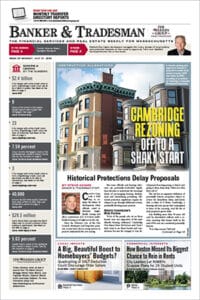Just a few years ago experts were warning the nation’s office market had peaked and was poised to steadily shrink in the years ahead amid seismic changes reshaping the American workplace.
Dramatic changes in technology, work styles and ruthless corporate efficiency had made the old-fashioned workplace a thing of the past, we were told.
However, a funny thing happened on the way to the funeral of the Great American Office Market, with both the amount of office space – and the amount actually occupied – both on a healthy upward trajectory.
And leading the way is Greater Boston, where the total amount of space leased to everyone from tech startups to banks and law firms is setting new records, having eclipsed the last office market peak reached in 2001, finds real estate market stat whiz extraordinaire Brendan Carroll.
“Despite the modern trend towards the efficient workplace, it’s very fascinating, in many regards, that the occupancy levels in Greater Boston are at their highest levels ever,” said Carroll, director of intelligence at Encompass Real Estate Strategy.
Boston is well above average when it comes to its office market occupancy rate. Nationally, office market occupancy is in the mid-80s and rising after plunging during the Great Recession.
But in the Boston market – defined as everything from 495 in – we are nearing 90 percent now and rising by the quarter.
More impressively, the total amount of space gainfully leased to big corporations and startups alike is now at a record 184 million in Greater Boston, up from 173 million in the first quarter of 2001, when the office market was inflated by the unravelling tech bubble, Carroll noted.
We are now a good 10 million square feet above the last high water mark, and it’s a lead that is only likely to grow larger as another 3.3 million square feet of new office towers and buildings comes on line over the next few years, Carroll said. The majority of that space – 60 percent – is already leased long before those new downtown high-rises open up.

Scott Van Voorhis
Telecommuting Not As Big As We Thought
All this stands in marked contrast to the predictions of just a few years ago that the glory days of the American office market were done and over.
Back in 2013, Norm Miller, a University of San Diego professor at the Burnham-Moores Center for Real Estate, put on a seminar for CoStar subscribers looking at the supposedly bleak road ahead for the nation’s commercial real estate market.
Miller offered up a startling projection: As much as 20 percent of the U.S. office market would eventually become redundant, with as much as $250 billion in office space destined to sit empty and useless. A top executive at Cassidy Turley, in a piece about the seminar, argued that even 20 percent might be too low.
But three years on, corporate America’s office footprint shows no signs of shriveling away, and especially not in booming Greater Boston.
The doomsayers aren’t all wrong – the office market is changing.
Telecommuting is a viable and pretty conventional option now for many workers, compared to a decade ago, when it was a novelty.
And the design and layout off office space has shifted significantly over the past few years. Companies of all types are looking to more open plans as they try to emulate the drive, creativity and efficiency of all those phenomenally successful tech startups that pioneered the collaborative workspace in the 1990s and 2000s.
But while office space and the way it’s used are undergoing major changes, it’s a far cry from the extinction scenario being bandied about a few years ago.
Sure, lots of workers are telecommuting now, but the numbers aren’t earthshattering.
Just 9 percent of all American workers telecommute roughly 10 out of 20 work days a month, according to a Gallup poll last year. Of the 37 percent who have telecommuted at one point or another, on average most do it two days a month.
Neither has the embrace of the open office plan led to a big decline in the size of the market.
By creating big, communal workspaces and ditching big, enclosed offices, companies have been able to cram more workers than ever before into the typical workspace.
A decade or two ago, the standard calculation was 250 square feet per employee. Now that’s dropped to as little as 150 square feet, Carroll said.
Demand has certainly fallen off in some previously key sectors of Greater Boston’s office market, but the gap has been filled, and then some, by other, newer players.
Boston once boasted a bevy of major banks, who left their mark on the city’s skyline in a flurry of tower building in the ’70s and ’80s. Now we’re down to one big bank, and it’s not even headquartered here.
Ditto for law firms, which have been steadily shedding office space as they find they no longer need big legal libraries and bulky filing cabinets in the new, digital age, Carroll pointed out.
But tech companies have become a major presence, not just in Cambridge, but in downtown Boston as well, with the Hub now one of the world’s top innovation centers.
And while most people think of lab space when it comes to biotech, each job in the field creates as many as a half dozen spin-off jobs in everything from administration to finance, insurance and legal services, Carroll noted.
Yes, the world’s changing. But we still need offices and office towers, especially in boomtowns like Boston. And that’s not likely to change anytime in the near future.









